I’ll probably repost this here in full later, but we just posted an update over on our High Hopes Project blog. Exciting stuff going on, read about it here: Next Design Challenges For Students.
I’ll probably repost this here in full later, but we just posted an update over on our High Hopes Project blog. Exciting stuff going on, read about it here: Next Design Challenges For Students.
In my job as STEM Learning Facilitator I travel hundreds of miles each month around the 6 counties in my region, but at times all around our state. One of the toughest challenges we face is the technology integration piece. Many (way too many) educators still possess minimal skills or knowledge in integrating technology, have limited access to technology, are blocked from most online collaboration enabling applications, are unaware of what is available (since it’s blocked) and misinterpret laws protecting students from online dangers. In addition, any use of technology (“We go to the computer lab for 30-45 minutes a week.”) is perceived as implementing the “T” in STEM effectively.
Furthermore, each school district has it’s own network, protected by their own security systems, and they tend to not relinquish access to those networks easily, even for someone coming in to train their educators.
So to enable us to do a much better job of delivering quality professional development (PD) we came up with the idea of a mobile lab to control for many more of the variables of access and hardware that have frustrated us and the participants in the PD sessions we offer.
I’m not going to spend time here explaining fully what led to the choices we made, but know there was thought that went into those choices. Cost was a big factor.
We chose to go with 21 Acer Chromebooks. The lab also contains 3 Verizon Mobile Hotspots so we have connectivity almost everywhere we take the lab that isn’t filtered, and 21 waterproof digital cameras so we can model integration and archive teachers’ learning to their own free Flickr accounts which we set up during trainings. The wireless hubs also enable showcasing and utilizing applications like blogs, wikis, Twitter and more during trainings and presentations so educators and administrators can perceive their education value. Thankfully, this also tends to foster discussion about safety and other issues that we can then deal with in an open way based on at least this initial experience.
Right now the lab sits in plastic tubs, but part of our plan is to develop a cheap, light transportation system that will also keep the components of the lab in good shape. We already have some ideas for that that I plan to share later.
(Below right) 21 Fuji digital cameras being charged for the first time – we chose these because they have fewer moving parts (the lenses don’t open and shut like most point and shoot cameras do these days), they are waterproof to 10 meters deep and are purported to survive being dropped from 5 feet … so hopefully they will take a bit more rough handling and if the opportunity arises could be used underwater … we’ll see. 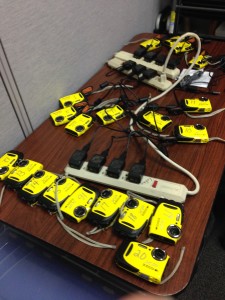
We’ve already had some success, even before obtaining the MSTL (Mobile STEM Technology Lab), in persuading one reluctant school district to open up blogs, wikis and Flickr on a trial basis to one school. We had discussions with teachers, administrators and school board members and demonstrated the educational value they were missing and explained that they would not be losing their E-Rate funding (a common misconception) if they allowed access to any social networking applications.
That promising experience actually helped us secure the funding for the MSTL.
We tried out the MSTL in a training last week in a classroom in the center of a high school with a very low, heavy metal ceiling and lots of suspended metal ductwork. We suspected in advance that that would slow connectivity, and it did, but we also know that most of the training sites we utilize don’t have that issue (and we’ve used the hubs in these locations and achieved good connectivity), so we are confident. I’ll keep you apprised of how things go!
Learning is messy!
I posted this over on our “High Hopes Project” blog and decided it fit well here too:
We refer to The High Hopes Project as a “model” STEM project. One aspect of that modeling is that we’ve designed it to include as many ways to participate as possible. To do so we have set up (so far) a project web site, this blog, a Twitter account, a Flickr account, a YouTube Channel, a Wiki and a Gmail account so we have access to tools like Google Forms for archiving and analyzing data.
In addition, any class or person can participate in the experiments we will send up by researching and theorizing based on what should happen, and then analyzing the data we gather and share about the atmosphere including temperature and pressure and in sending up the world’s “High Hopes” – including yours (more explanation about those aspects will be shared along the way – we don’t launch balloons until April and May) .
However another characteristic of this project is we chose 3 local schools to participate in certain engineering designs for the project to act as surrogates for all of us (an elementary, middle and high school). We contemplated opening up the major engineering design portion of this project to the world, but realized quickly that receiving design ideas from potentially tens if not hundreds of classes from around the world would be beyond our time constraints and abilities to judge and implement.
Doug Taylor who co-designed this project looks on as a student explains the mock-up of the High Hopes payload and release mechanism the class is engineering and building.
The first one of the engineering challenges the students in Mr. Walsh’s physics class at Sparks High School are tackling is how to release the “High Hopes” the world submits so they can be spread around the world – more than likely they will be printed on small strips of paper – the paper we use breaks down in the environment in a matter of weeks BTW, so our High Hopes will become one with the Earth. One batch of the High Hopes will be designed to helicopter or glide in the air (to be designed by the elementary students) and have to be released at a lower altitude, but the bulk of the High Hopes will be released as high as possible (around 100,000 feet or 33,000 meters). So that requires 2 payloads.
The students informed us a week ago that they had done some initial designing and had some mock-ups to show us, but more importantly had questions about requirements and conditions to deal with. We set up a time to meet with them and included Andy Smith who is a mechanical engineering graduate student at the University of Nevada, Reno. Andy is close to receiving his doctorate degree in engineering and has launched over 50 balloons himself, as well as designing payloads and the communications devices required to track them so they can be recovered. He has agreed to consult with students throughout the project.
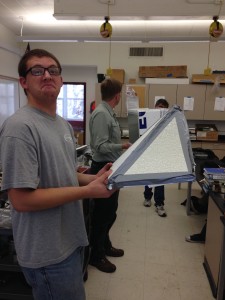 The students showed us 2 designs – one basically a pyramid shape they envision being a bit more aerodynamic and stable, and another shaped more like a rectangular prism. The rectangle design also had a rudimentary release mechanism built in. They had chosen styrofoam sheets, as the material … oh and the ever ubiquitous duct-tape.
The students showed us 2 designs – one basically a pyramid shape they envision being a bit more aerodynamic and stable, and another shaped more like a rectangular prism. The rectangle design also had a rudimentary release mechanism built in. They had chosen styrofoam sheets, as the material … oh and the ever ubiquitous duct-tape.
One question they had was about payload size. They had no idea just how many “High Hopes” they had to transport, but they assumed about a ream of paper worth (500 sheets). In fact they had placed a ream of paper inside their initial designs and dropped them from their school building as an initial test and both survived intact. We explained we really had no firm idea just how many we might receive over the months before we launch, but that their test seemed like a good start.
Andy answered their questions about release mechanisms and how to release the High Hopes at the right moment. They discussed the possibility of using arduinos they could build and program, perhaps based on altitude readings. Andy also made them aware of some of the other design issues they would have to overcome including temperature, high and very low humidity, and high winds … and that some glues and other materials don’t do well under certain conditions.
Andy answering questions about engineering design.
We’ll keep you updated as designs progress. PLEASE SIGN-UP TO BE PART OF THIS PROJECT!
Learning is Messy!!
 It’s been over a year since I last posted about RECON (Research and Education Collaborative Occultation Network). From the project web site:
It’s been over a year since I last posted about RECON (Research and Education Collaborative Occultation Network). From the project web site:
“Have you ever wondered what’s found in the outer reaches of our solar system? It turns out many, many objects orbit the sun out past Neptune. Called trans-Neptunian objects (TNOs), these frozen bodies were formed at the same time as the rest of our solar system – making them close to four and a half billion years old. Determining the sizes of these objects will help us better understand their formation and composition, and could tell us a great deal about the origins of our solar system.”
And:
“To measure the size of a TNO, we use the shadow it casts on Earth as the TNO moves in front of a distant star – an event called an occultation.”
Tonight … well really very early Saturday morning, our network of 14 telescopes at 14 sites that stretch from south of Reno, Nevada, to the California border, will focus our telescopes on a star so faint we probably won’t be able to see it with our eyes … even with a powerful 11 inch wide reflecting telescope. So to even find it we zero in on a field of stars we know the target star will be in the middle of. Then we attach a camera, or in this case a laptop computer and record the image during the window of time that the event is supposed to take place (Early Saturday morning, November 15, from 2:10-2:30AM Pacific Time). Follow the link above to the project web site to learn more about how this works – it includes photos and a video of an occultation (think eclipse – that’s basically what an occultation is).
The project has been so successful that it was just funded to increase the number of sites and telescopes to reach from the Mexican border in the south, to the Canadian border in the north.
Students (mostly middle and high school students) are recruited to be part of the teams of citizen scientists (all of us volunteer) to make the observations, record the data and even help analyze and share the results. Most of the participants are teachers that recruit their own students and community members to be part of the research team.
Here’s a link to a post about tonight’s campaign including photos, maps and charts.
Learning is messy!
“Reading” Sebastien Wiertz
Close reading is one of the “strategies du jour”.
From the Common Core State Standards in ELA:
1. Read closely to determine what the text says explicitly and to make logical inferences from it; cite specific textual evidence when writing or speaking to support conclusions drawn from the text.
In addition from the Harvard Writing Center:
The second step is interpreting your observations. What we’re basically talking about here is inductive reasoning: moving from the observation of particular facts and details to a conclusion, or interpretation, based on those observations. And, as with inductive reasoning, close reading requires careful gathering of data (your observations) and careful thinking about what these data add up to.
In pretty much all trainings and presentations I deliver about STEM learning, I stress how STEM is language intense. I go so far as to state that it is one of the most powerful language arts interventions available. But that is only true if you take advantage of the language learning (and loads of other learning possibilities) that STEM provides.
STEM learning is somewhat its own enemy because often the activity or experience involved is so interesting, intriguing or engaging (or all 3) that the students get excited and talk about it excitedly (and often parents voice how excited their child was when they came home) and teachers assume everything (or enough) important was learned. What is probably more often the case is that the lesson/learning experience was just about the STEM learning and integrating the language arts either isn’t part of the plan, the time to integrate isn’t perceived as important, or the usual issue of not feeling there is time rears its head.
This is a powerful learning opportunity missed. Really opportunities missed. Let’s focus on just one. Instead of “close reading,” we’ll refer to it for lack of a better name as “close doing” (but we could call it “close making” or “close observing” or other possibilities).
I point out repeatedly how too often field trips or major hands-on activities (doing or making activities) are planned to be experienced as either stand alone experiences or end of unit experiences with little to no emphasis on how they tie to the overall learning plan. Will the learning be integrated into all subjects or are those connections just assumed to be made? What if instead these experiences were provided early on in the unit? Example: Students are learning about animals- adaptations, habitats, and so forth. After a bit of learning about what adaptations and habitats are, we take a trip to a zoo or wildlife park to observe and learn about animals. Students are required to take notes and ask questions about the animals habitats and adaptations and take digital photos and video clips of animals, but also information displays and more.
Trips like these are usually exciting for students and even lead them to wonder and wanting to learn more. But often (as stated above) this also marks the end of the unit; “That was fun kids, next week we start learning about the planets!” Here’s where I propose “close doing” comes in. Using students memories, notes and photos (which I always archive somewhere like Flickr (free) so students, families and collaborators have access to them) we make close observations about each animal – what were some of the characteristics of each animal that helped them adapt (claws, fur, shells, eye size, … ) – colors, but more – not just white, but creamy white and white like a cloud or milk – even emphasize really what color white was it, cloud white? Pearl white? Cream white? Which is the best descriptive color, or texture, or simile to something man-made for example.
All the senses should come to bear: What did animals, their parts, their habitats, etc. look like, feel like (or look like they feel like if you couldn’t really touch them)) smell like, sound like … go deep! This takes time AND should probably happen during your language block, not just a science period (but could be both) because this is language study as much as it is science. Students should be taught and challenged to be close observers and inferrers. Just as close as they have to be when they are close reading.
The same is true for the hands-on activities- the doing and making experiences the students have. What did you observe during that experiment or construction/engineering piece? What were all the happenings, colors, actions, reactions and so on that you saw and explain what each one had to do or didn’t have to do with the overall result? Thinking “close” about how you observe and do and problem solve and more, about any of these aspects of a project or unit. (NOTE: You wouldn’t do the super intense “close doing/observing” with every part of the project – that’s as stifling as overdoing close reading – I’m saying consider picking some part of the learning or doing and do it every once in a while – a couple/three times a year maybe – then you have built and practiced those essential skills and have those “close doing” schema experiences to relate to in other subjects as well).
Just like it takes many readings and lots of probing questions to facilitate “close reading” skills and thinking, the same is true of observing and noting all of what was observed and/or done in “close doing.” Getting students to note all the meaning is the goal here too.
The vocabulary that comes from these experiences is amazing … and because it is based on schema all the students build together, and have in common, it becomes a valuable reading instruction resource later; “Remember when we saw that bear at the zoo and he seemed both scary and cuddly at the same time? How does this character remind you of that? Or how is this character different than that?” OR “Remember how we noted that the bear’s fur was brown like the bark on a redwood tree?” Why do you think this author chooses the colors she uses to describe the buildings and streets in this chapter?”
Then, because students have thought and taken notes about not only facts, but color, texture, actions, behaviors, and much more, they are scaffolded to write incredible descriptive poetry, stories, captions for the photos they took, narrations for videos that share and assess their learning and so much more.
“The second step is interpreting your observations. What we’re basically talking about here is inductive reasoning: moving from the observation of particular facts and details to a conclusion, or interpretation, based on those observations. And, as with inductive reasoning, close reading requires careful gathering of data (your observations) and careful thinking about what these data add up to.”
Remember this quote about close reading above? Re-read it and note how it fits with STEM learning. Ingesting that motivating, hands-on learning and taking the time to “interpret” it – then sharing through text or video, or podcast, or any number of other publishing portals … and preferably shared online to promote and obtain the benefits of connected and collaborative learning as well – emphasizing that “close” idea, just not only with text.
Let’s change out some of the words from the definition of close reading from above:
“Think about and do closely to determine what the research, experience, investigation and inquiry says explicitly and to make logical inferences from it; cite specific _ evidence when writing or speaking to support conclusions drawn from the research, observation, collaboration, inquiry and experience.”
So what I am saying is, is that STEM or inquiry learning is just as important and valuable a language arts learning opportunity as reading text, if the vocabulary and writing and research are emphasized and connected to close thinking and inferencing skills. And it provides another avenue or method to connect students struggling to interpret text to thinking about and explaining meaning and learning. Not saying it takes the place of reading text, just that it is as important to do because students are just as weak at interpreting, citing and inferring from other inputs, and articulating from them is just as important.
And if you build students “close doing” skills, the next time you are doing “close reading” – you have built schema for being successful at that as well: “Remember how long it took us to come up with “redwood bark” as a great description of the bear’s fur? How frustrated we were for awhile? But then when we came up with that and saw how near perfect it was as a description … how excited and motivated we were? That’s what we have to do now as we think about this text passage.”
Also note – if you are trying to jam STEM learning into a crowded schedule (STEM is a culture, not a time of day or day of the week), here is your valid reason and method to truly integrate it.
Learning is messy!
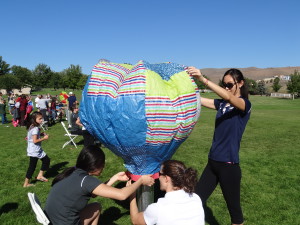 In an earlier post I quoted a press release that stated that 900+ students and teachers would participate in the Great Reno Balloon Race, Tissue Paper Balloon Launch Day. A last minute surge of participants put the number closer to 1100. And note that teachers can only bring their classes if they have attended one of our trainings on how to construct a tissue paper balloon. These trainings have been going on for years, so there was a greater number of teachers that could participate than we thought would register.
In an earlier post I quoted a press release that stated that 900+ students and teachers would participate in the Great Reno Balloon Race, Tissue Paper Balloon Launch Day. A last minute surge of participants put the number closer to 1100. And note that teachers can only bring their classes if they have attended one of our trainings on how to construct a tissue paper balloon. These trainings have been going on for years, so there was a greater number of teachers that could participate than we thought would register.
With the help of the University of Nevada, Reno, Swim and Dive Team we ran 10 of our 14 launchers non-stop to not only launch every balloon, but also numerous re-launches after students re-engineered their balloons after their first launch, making changes to get the most out of their balloon. Usually this involved cutting the weight and patching holes. We had tables set up with tape and scissors and glue sticks to encourage just such re-engineering.
The Great Reno Balloon Races contacts all teachers that have been trained, makes them aware of the date of this year’s launch, pays for their materials to construct their class balloons, transportation to the Great Reno Balloon Race site, provides volunteers and then feeds all participants a barbecue lunch. Some participants have an 80 mile round trip … all paid for … a fantastic resource to get teachers and students involved in STEM learning. The Great Reno Balloon Race staff are totally supportive of the entire endeavor. And now we are talking about expanding the program to include even more students and teachers! 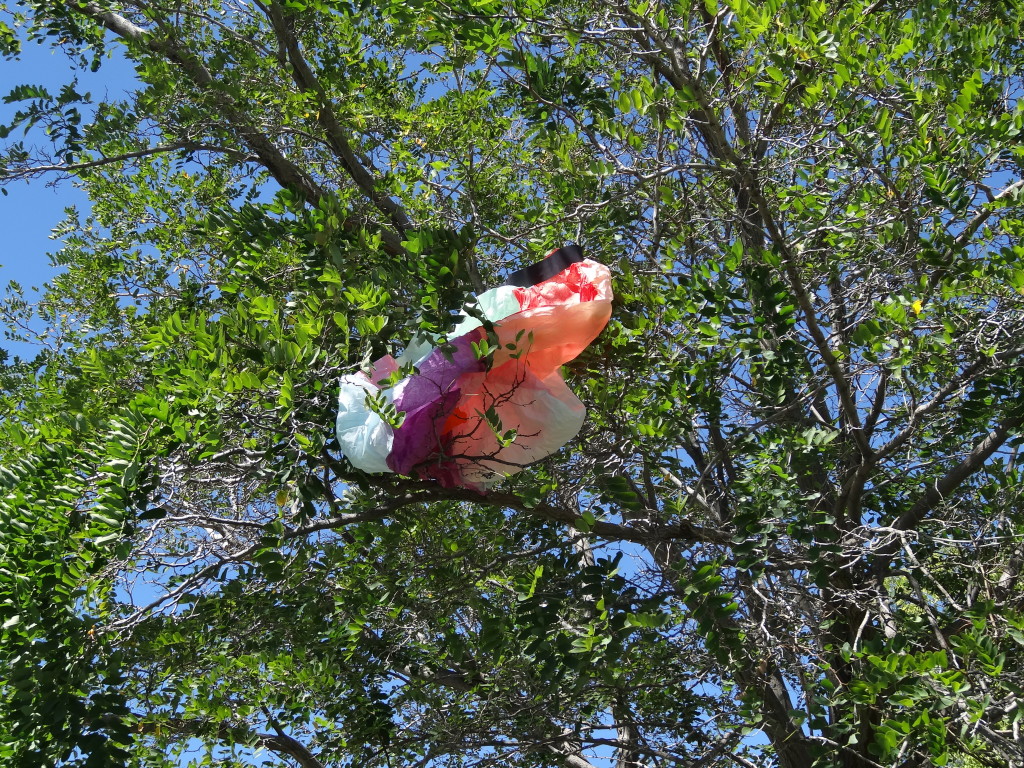
The wind decided to change directions late in the morning. This led to some “Charlie Brown Kite-In-The-Tree” kind of experiences … about 3 out of hundreds. We’ve already planned to make that less likely next year.
Besides the Tissue Paper launches, we also launched 3 high altitude balloons, one about every 45 minutes or so. These were part of making students and teachers aware of this years expanded “High Hopes Project.” During the spring of 2015 we are planning to launch probably several balloons up to 100,000 feet (30,000+ meters). We collected “High Hopes” – from students, stuffed them in the balloons and sent them up to 60,000 feet – so their “High Hopes” went up high. We will share much more about this school year long project soon.
There’s no reason we should have all the fun and learning though. So I just posted about how to construct a tissue paper balloon, and also the launchers we used. Try this incredible STEM learning experience yourself!
Here are links to more photos and videos of launches:
Learning is messy!
Note: If after reading this post you decide to participate leave your “High Hopes” Here.
 Doug Taylor and I started the High Hopes Project back in 2010, when we were both teaching 4th grade. Doug had seen this article about MIT students sending a styrofoam cooler attached to a balloon with a camera inside to near space and thought it would be a great way to study the layers of the atmosphere and other topics we were supposed to teach. Besides the science, language arts and other curriculum the project uncovered, we hit on the idea of having the students write their “High Hopes” for their school, community and the world. We shared the idea on this blog HERE, on our class blog, and I spent much of my TEDx Talk in Denver that summer describing the project.
Doug Taylor and I started the High Hopes Project back in 2010, when we were both teaching 4th grade. Doug had seen this article about MIT students sending a styrofoam cooler attached to a balloon with a camera inside to near space and thought it would be a great way to study the layers of the atmosphere and other topics we were supposed to teach. Besides the science, language arts and other curriculum the project uncovered, we hit on the idea of having the students write their “High Hopes” for their school, community and the world. We shared the idea on this blog HERE, on our class blog, and I spent much of my TEDx Talk in Denver that summer describing the project.
We are planning our biggest launch yet during the spring of 2015. To kick off this project, which will be explained in more detail in future posts, we are launching 3 high altitude balloons this Friday from the Great Reno Balloon Race while 900 students are there to launch their own tissue paper balloons (see previous post). The balloons will make it to about 60,000 feet ( 18,000 meters) and will carry the “High Hopes” of anyone that sends us their “Hopes” by this Thursday night (9/4/14). In addition we will send them up this spring during the larger project.
To participate either write a “class high hope” or have students submit their individual high hopes in the format: “I live in (Optional), and my “High Hopes: for my school, my community and the world are …”
Here are some actual examples written by our fourth graders in 2010:
I live in Sparks, Nevada, and My “High Hopes” for school include graduating high school and working hard to improve my grades. But my Highest Hope for school is to graduate college and get a good job that I like.
I live in Sparks, Nevada, and my “High Hopes” for my community include police because they keep us safe, hospitals because they can heal and fix the injuried and schools so we can graduate school.
I live in Sparks, Nevada and my High Hope for the world is ending homelessness because it’s kind of sad that someone has no roof over their head.
Learning is messy!
From a Press Release today:
“900 Students from northwest Nevada will descend on Rancho San Rafael Park in Reno, site of the Great Reno Balloon Race, on Friday, September 5, 2014, to launch their own hot air balloons which they designed and constructed from tissue paper. In addition they will witness the launch of several high altitude weather balloons that will carry student authored “High Hopes” to altitudes of 30,000 feet or more.”
LEFT: Teachers learning to construct a tissue paper hot air balloon during a training in July 2014.
Specially designed launchers will be utilized to fill each balloon with enough hot air to send it aloft.
About 10 of these launchers will be available to launch student balloons.
BELOW: The tissue paper balloons are slipped down over the launcher and filled with hot air, then released when they become buoyant.
As part of learning the “engineering design process” required by the Nevada Academic Content Standards in science (Nevada adopted the Next Generation Science Standards), students will have resources available on-site to improve their design and then relaunch to assess their engineering skills.
BELOW: A video clip of a launch from last year’s event.
Learning is messy!
3 weeks ago we participated in the Nevada Tahoe Teacher STEM Institute. Over 50 K – 9 teachers from all over Nevada came to the Tahoe Environmental Research Center (TERC) at Sierra Nevada College in Incline Village, Lake Tahoe, for a week of STEM learning. The funding was based on a Math/ Science Partnership Grant we wrote and received through the Nevada Department of Education. The event was put on by the Nevada’s Northwest Regional Professional Development Program, Washoe County School District, TERC, along with help and support from others mentioned in this post. BELOW: We started off with a group photo.
Sunday evening we started them off learning the science of tie-dye (covalent bonds and all) and made the case for STEM learning. We also set up a STEM notebook for each teacher as well as a digital notebook (blog).
The next day started at 6:30 am for breakfast and a day of Project WET, GEMS (Great Explorations in Math and Science), background in the Next Generation Science Standards (NGSS), a trip on the TERC research vessel on Lake Tahoe, stream studies and training on and set-up of blogs, wikis and a Flickr photo account – all of which we added to all week.
GEMS – Great Explorations in Math and Science
Out on the TERC research vessel
ABOVE: Field Lab Director Brant Allen explains the use of a Secchi disk in reporting out the clarity of the water in Lake Tahoe. The clarity has degraded from over 100 feet to about 70 feet since the 1960’s. BELOW: Secchi disk being lowered into the lake.
A couple of past visitors to the TERC research vessel you might recognize: 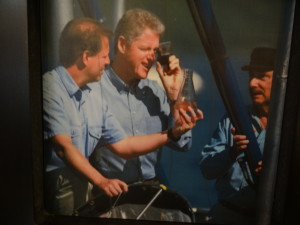
BELOW: Stream monitoring and benthics.
During following days all teachers learned geology, aquatic habitats, space science, ocean science, food webs, the ethics of teaching outdoors – and the middle and high school teachers also worked in the Soluble Reactive Phosphorous Lab solving a mystery about pollution sources ala CSI. The grant provided experts from GEMS, TERC the USGS and others to teach classes and lead labs.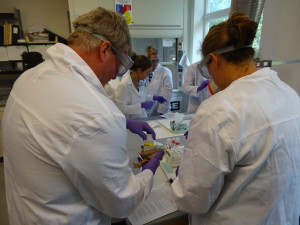
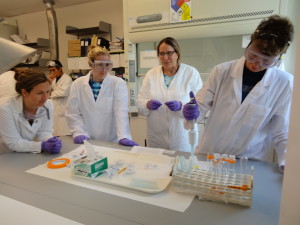
In the Soluble Reactive Phosphorous Lab
BELOW:Food webs
Ladybugs!
Participants loved the “Digital Sandbox”
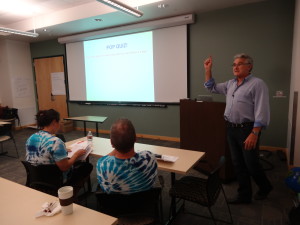 Geoff Schladow – Director of the Tahoe Environmental Research Center explains the “State of the Lake.”
Geoff Schladow – Director of the Tahoe Environmental Research Center explains the “State of the Lake.”
We also got to visit the lake at sunset:
Besides the more than 40 hours of training, participating teachers each received lessons, supplies and other resources to take back to their classrooms and students so they can use what they learned right away. In addition teachers will have monthly follow-up sessions to share their progress, ask questions, share resources they have developed and make connections through the classroom blogs, wikis and Flickr accounts they set-up. It was an intense and rewarding week of learning and sharing in one of the most beautiful locations on Earth!
Learning is messy!
Why should education leaders embrace digital technologies in their schools? 
1) If you are in a state that adopted the “Common Core State Standards” (CCSS) you really don’t have a choice. There are many (yes many) English Language Arts standards alone that require students as young as kindergarten to use technology to read, produce and publish digital content and to collaborate in doing so. Just a few examples from the CCSS:
K – 12 – Use technology, including the Internet, to produce and publish writing and to interact and collaborate with others.
K-12 – With guidance and support from adults, explore a variety of digital tools to produce and publish writing, including in collaboration with peers.
6th grade – (NOTE: by 6th grade the “… guidance and support from adults …” is gone. 6th graders are to master this standard on their own) Use technology, including the Internet, to produce and publish writing as well as to interact and collaborate with others; demonstrate sufficient command of keyboarding skills to type a minimum of three pages in a single sitting.
5th grade – Analyze how visual and multimedia elements contribute to the meaning, tone, or beauty of a text (e.g., graphic novel, multimedia presentation of fiction, folktale, myth, poem).
I’m not sure how we get our students to the mastery of these standards, and many others without ubiquitous access to and utilization of the technologies required.
2) Collaboration – This was already stated in the standards above, but those were specifically language arts standards. Communication and collaboration are already key to being educated, but also in getting a job. Learning to collaborate with the student next to you in class or in your group is great, but technology makes it easy (yes, easy) to collaborate globally. Will it be “good enough” if students just learn to collaborate in class? Will that foster solid collaboration skills with today’s (and tomorrow’s) technologies? Not that getting a job is the only reason to learn solid collaboration skills, but getting a job without having those skills is not getting easier. Mastering all the ways collaboration is leveraged personally and using technology is vital.
3) Programming and design – 3D printing (did you know they are printing whole houses, food and blood vessels already?), also – software development, engineering, graphics, architecture, transportation, art, medicine, and much more all rely on programming and design skills … this is what is happening now in fields with good paying jobs.
4) Inventing (often referred to as “making” these days) – This is hands on and motivating and requires the skills developed through pedagogy that includes all of the above.
5) Problem solving – (See above)
So you think children are already mastering these skills and technologies on their own by using their smart phones and other technology 24/7? Ok, let’s see how that works out with your students.
I don’t pretend that I’ve included all the reasons that leaders should consider (please add your own in the comments). But these are not easy or cheap changes that have to happen. We’re not going to provide the technology and professional development and commitment to change on the cheap. Only real leadership will get us there.
Learning is messy!